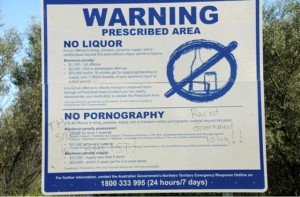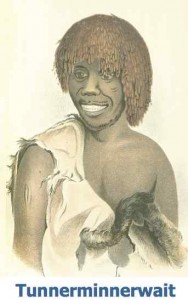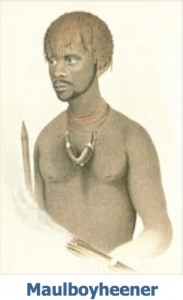Gavin Jones, founder of the Deadly Awards, Deadly Vibe and celebrations of indigenous peoples, died recently. Fairfax Media’s Rick Feneley penned this piece.
The Aboriginal founder of the Deadly Awards, the annual celebration of indigenous achievement, was shattered last month when he learnt that he would lose federal funding worth hundreds of thousands of dollars.
Gavin Jones, 47, was found dead on his farm at Goulburn on Saturday. While his family did not want to discuss the nature of his death, they and his friends were aware of his devastation at the loss of funding affecting his ventures, which had spawned radio and television productions, the national Deadly Vibe magazine, the annual Deadly Awards, sport, dance and hip-hop events, and much more.
“Yes, it was a huge blow to him,” said his long-time friend Shelley Reys, who shared offices in Darlinghurst with Mr Jones when they were establishing their indigenous consulting businesses in the 1990s.
“He was very disappointed by the lack of support, not just to the business but to what the business provided to young people.”
On Monday night, Vibe Australia, which runs the Deadly Awards, revealed this year’s event had been cancelled because of the funding cuts. The awards had been due to take place on September 30.
Vibe Australia said it had been informed in June that funds for the Vibe Project would be redirected to federal government programs that deliver “frontline” services from July 1.
There was no confirmation of a suggestion by some of Mr Jones’ friends that he had been forced to lay off staff as a result of federal cuts worth as much as $400,000.
However, Vibe Australia confirmed the federal funding cuts brought to an end the entire Vibe Project, which Mr Jones spent two decades building – including the Deadlys, Deadly Vibe and InVibe magazines, Deadly Sounds radio, Move It Mob Style TV and deadlyvibe.com.au.
But in a statemtn on its website it said “our commitment to Vibe and our belief in the work we do on behalf of the community remains firm”. Fairfax Media understands Vibe Australia is not sure how it will secure its future.
Mr Jones started the Deadly Sounds music and culture radio show at Boomalli Aboriginal Artists Co-operative in Redfern in 1993. That spawned the Deadly Awards – the 20th celebration of which, at the Opera House, was to be screened on SBS and watched by as many as seven in 10 indigenous Australians.
The awards celebrate music, sport, entertainment and community achievement and have put the spotlight on performers including Yothu Yindi, Archie Roach, Jessica Mauboy and Dan Sultan.
Mr Jones established the Deadly Vibe Group and Gavin Jones Communications. Much of his work, including on government programs, focused on healthy lifestyles and anti-drug messages.
Do you know more? Contact Rick Feneley at rfeneley@fairfaxmedia.com.au
In indigenous patter, “deadly” means great or wonderful. “Back then [in 1993],” Mr Jones said recently, “about the only Indigenous band people recognised were Yothu Yindi, and I knew there was so much more. So I bit the bullet and started the radio show Deadly Sounds.”
Still executive producer of the awards, he was proud they attracted a record 95,000 votes last year and were watched by about 500,000 people.
“He was a visionary,” said Ms Reys. “He was a huge personality. He was larger than life. He did everything with style and flair.
“There was an exuberance that was contagious to the people who spent time with him and were swept up in that exuberance. Many have said to me ‘It’s hard to imagine a world without Gavin Jones.’
“He inspired young indigenous people before we even really knew what that meant. He was building and inspiring, connecting young Aboriginal people with one and other and the wider community.”
Some friends understood Mr Jones learned of the funding cuts in the middle of last month, despite a recent audit which had given his ventures a glowing report.
While Ms Reys did not know the details of the funding cuts, she said: “He was devastated.”
Mr Jones’s ventures also included The Vibe 3on3, a national music and sporting event to promote health, wellbeing, identity and sportsmanship and Move it Mob Style, a dance-based health program screened on the indigenous channel NITV and ABC.
In 1995 he launched Deadly Vibe magazine, which delivered positive Indigenous stories and health messages directly to schools and communities. At the time of his death it had reached its 209th issue and had a monthly national distribution of 55,000, mostly students.
Mr Jones wrote in the editorial for the 200th issue last year: “Overly negative media was the reason why we started Deadly Vibe magazine. To put something positive in the hands of our young people; something of a high professional quality that could be read and handed around at home or school that told a different story. A story we could be proud of. A magazine that was ours. Something that had blackfellas achieving and breaking stereotypes – achieving in music, sport, at a community level, in the health sector, at school and in the work force. Something our young people can get excited about, and be justifiably proud.”
InVibe magazine, an insert into Deadly Vibe, was produced specifically for Aboriginal and Torres Strait Islander people in prison and juvenile detention centers and focused on mental health, sexual health, information on substance abuse, and promoting pride and self-worth.
Actor and cultural leader Rhoda Roberts worked closely with Mr Jones as the host of Deadly Sounds and as co-artistic director of the Deadlys for several years, among many other projects.
“What a blessing, when 21 years ago Gavin and I sat in a coffee shop and talked about how great it would be to have a national radio program, our own AFIs, and a magazine, and look what he did with his wisdom, passion and love for all our mob,” she said.
“So many seedlings have been produced across the industry because of this one man and his passion. He really was a pioneer, and I thank you deadly brother. Rest, then dance well with our mob because you will always be in our hearts and are one of greatest shining stars.”
Vibe Australia last night issued a statement hailing its leader as “a true pioneer”.
Mr Jones was born on the traditional lands of the Ngunnawal and Gundungurra peoples at Goulburn. While he grew up in the provincial town between Sydney and Canberra, the family’s roots were in Bigga, Binda, Crookwell and Tuena. He was raised by his mother, father and grandmother, along with his three sisters.
He started a journalism cadetship at the Goulburn Post before completing a communications degree at the University of Canberra in 1989. He worked in journalism across various government departments.
The company he founded in 1993, Deadly Vibe, had a mission to: “Support all Aboriginal people and Torres Strait Islander people in reaching their full potential by providing positive imagery, identifiable role models and quality media to improve community and quality of life.”
“Deadly Vibe launched a series of unique and successful products, all reinforcing the importance of self-worth and self-esteem to the overall health of the Indigenous community by the promotion of positive Indigenous stories, and focussing upon the achievements of Indigenous Australians across all aspects of society, along with targeted health messaging,” the Vibe Australia statement said.
“Importantly, this approach came at a time when the national media cycle served only to reinforce negative stereotypes and negative depictions of Indigenous Australians. It was this negative and ‘unhealthy’ imbalance in the reporting of Indigenous peoples and communities that spurred Gavin to launch Deadly Vibe.”
In a 2012 interview, Mr Jones said of the Deadly Awards, commonly known as the Deadlys: “Like the whole Vibe organisation, I see the Deadlys as a vehicle to empower our people. Indigenous health is a disgrace, but I see our work as a way of improving this. If people are proud of who they are and where they come from, then that will lift their self-esteem. And that can only lead to better health.”
In 2008, Mr Jones launched Vibe TV, which produced the programs Living Strong and Move it Mob Style, which is broadcast on NITV and ABC3. It was nominated for a Logie award in the children’s entertainment category this year.
“Gavin leaves behind an impressive legacy, and will be remembered as a man who made a huge contribution to his community, and helped to change the fabric of Australian society, providing successful and impactful nationwide platforms for Indigenous Australians to celebrate their achievements, survival, pride and culture,” the Vibe Australia statement said.
Former Aboriginal and Torres Strait Islander social justice commissioner Tom Calma said: “Gavin Jones is a true hero of Aboriginal and Torres Strait Islander peoples. He was selfless and he dedicated his life to celebrating our achievements and inspiring our youth in particular to develop the resilience they need to face their future. RIP Gav.”
Film, stage and television star Luke Carroll, a long-time host of the Deadly Awards, said: “The Australian community, not only the Aboriginal and Torres Strait community, has lost a genuine leader of people.
“Gavin Jones was a mentor, brother, father figure, and great confidant, not only to me, but to so many within the Aboriginal and Torres Strait Islander entertainment, sporting, and grass roots community.
“His ambition and drive in promoting our people on the biggest and brightest stage possible was his passion, and he did this without any thought of personal gain, he was the most giving and generous person I have ever known and his legacy and the ramifications of his death will be felt for many generations to come.
“There is a massive void that is left from his absence, and we must never, ever forget the contribution he has made. I will love him and continue to love him. We all miss you Gav, and we’ll see you in the Dreamtime.”
Read more: http://www.smh.com.au/entertainment/deadly-awards-founder-gavin-jones-dies-after-funding-cut-20140714-zt78p.html#ixzz37UJ1mVXy







